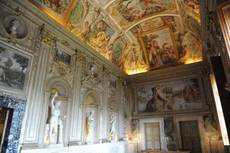PALAZZO FARNESE'S CARRACCI GALLERY TO SHINE ANEW
By Sandra Cordon
27 febbraio, 17:59 (ANSA) - Rome, February 27 - For the next year, as many as
30 restoration specialists will be involved in a major
international project to restore Baroque-era masterpieces in
central Rome's Palazzo Farnese.
(ANSA) - Rome, February 27 - For the next year, as many as
30 restoration specialists will be involved in a major
international project to restore Baroque-era masterpieces in
central Rome's Palazzo Farnese.The grand palazzo, which is at present home to the Embassy of France, boasts magnificent frescos by Baroque master Annibale Carracci and his brother Agostino in what has been called the Carracci Gallery.
Developed between 1597 and 1608, the gallery has been described as the Baroque "response" to Michelangelo's Sistine Chapel.
It includes the monumental fresco cycle The Loves of the Gods, including the Triumph of Bacchus and Ariadne, depicting a great feast of the gods, nymphs and other mythical creatures joining in. The 800,000-euro restoration project, which will begin in mid-March, has been in the works for several years and will be partly funded through the French embassy, Italy's ministry of cultural heritage and the New York-based World Monuments Fund (WMF) in Europe.
The latter is said to be the largest private international organization dedicated to preserving important monuments. The project is drawing international attention and accolades.
"The whole building is a masterpiece," says Erkki Maillard, a minister-counselor of the Embassy of France.
"The Carracci Gallery is for us a place of daily work, but also a testimony to the genius of European culture," added Maillard.
The gallery, stretching 20 meters long and seven meters wide, was commissioned during the Counter-Reformation period on the occasion of the wedding of Ranuccio Farnese and Margherita Aldobrandini, niece of Pope Clement VIII.
The barrel vault ceiling is famed for its play of materials, trompe l'oeil (trick of the eye) and the sweeping Carracci frescoes inspired by Ovid's Metamorphoses as well as various figures that followed the style set by Raphael.
The value placed on the gallery meant that it has been restored at times in the past, including an urgent fix ordered in 1994 when the ceiling threatened to collapse.
Now, new cracks and leaks that threatened the masterpieces inside have demanded an immediate response to protect what many call a significant piece of cultural heritage. "For centuries this has been the model of all galleries in Europe," said Bertrand du Vignaud, president of WMF Europe.
"In these frescoes, there is great poetry and we cannot doubt that the (restoration) work may reveal some more surprises, revealing details not yet known".
The tender for the project was awarded to the consortium ATI Farnese at a cost of 800,000 euros, with the team of 30 restoration experts who will also help to stabilize the gallery.
According to du Vignaud, funding also comes from the Robert W. Wilson Challenge to Conserve our Heritage foundation in the United States, and France's Fondation de l'Orangerie. The work is expected to continue for a year before it is reopened to the public.
The project, said Maillard, will be extensive.
"Because of its importance and beauty, we opted for a complete restoration, and not just for a cleaning".










